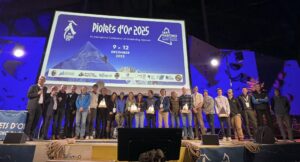Christian Black, Vitaliy Musiyenko, and Hayden Wyatt of the U.S. have opened a beautiful line on White Sapphire (6,040m) in India’s Kishtwar Valley. They graded the impressive 850m route 80*, AI3, M7+.
On social media, Musiyenko said that the entire valley is full of “badass” peaks, and the question was not finding a suitable route to open, but to decide which and where.
“It’s not about the peak; it’s about the hilarious stories you gather along the way,” Musiyenko wrote, after describing how a malfunctioning stove thwarted their first attempt.
Before their second, successful go, the climbers had to deal with bad weather and radical changes in mountain conditions. “[The White Sapphire] looked as pristine as a diamond ring on the approach, but winter hit, and the face we were hoping to climb turned into Cerro Torre’s ice-covered twin,” Musiyenko said.

Rough overlay of Brilliant Blue (850m, 80 degrees, AI3, M7+). Photo: Vitaliy Musiyenko
Details of the climb
Musiyenko shared details of the climb with ExplorersWeb.
“It snowed every day for about three days straight,” Musiyenko said. “Then we gave it one day to ‘dry’ a little and went for it. On the upper part of the route, we had about 10 straight pitches of difficult dry tooling. We had to do a lot of cleaning with our hands to find some sort of gear placements, a cold and strenuous endeavor.”
He admitted that he had only ever been that cold in Alaska.
Below, Musiyenko describes their two-day climb:
We started on Oct. 5 from high camp at 15,800 feet and climbed a prominent ice gully left of the central buttress to a col. We negotiated a vertical, detached water ice pillar to get over the bergschrund and into the gully.The ice gully. Photo: Vitaliy Musiyenko
From there, we had a 1,300-foot simul climb (up to about AI3 M3) with intermediate belays using a micro-traxion on every rope length. (We brought six.)Then we simul-climbed two shorter blocks (650 and 350 feet), with difficulties to AI3 M4+. Two more pitches (M5 and M6 — 240 ft) took us to the col. [That was] 2,540 feet of roped climbing on the first day after getting over the bergschrund.We slept, or attempted to, on top of a huge overhanging cornice at 19,100 feet. We slept in our harnesses, tied to an anchor.The last pitches before the summit ridge. Photo: Vitaliy Musiyenko
On Oct. 6, we waited for the sun to come up and melted plenty of water, as we were expecting a full day of hard climbing. Two consecutive M7+ pitches (360 ft) took us to easier terrain. Two more pitches (M4 and M5 380 feet) got us closer. Then, a 220-ft pitch of M6 R took us to the base of the summit pyramid. Here, an M5-6 boulder problem took us to the summit ridge and the top. We spent about an hour there celebrating…took photos of the summit area and each other, sent InReach messages to family and snapped the summit elevation/coordinates for proof to the Indian Mountaineering Foundation.
As soon as we left the top, the winds picked up and our bodies realized that we were cold, tired, and hungry for anything warm. Four full rope rappels took us back to the col. We continued the celebration by rubbing each other’s feet and melting snow till way past midnight. Soon after going to sleep and dreaming about seeing the sun in the early morning, we woke up to wind and snow blasting our tent. C’est la vie.Photo: Vitaliy Musiyenko
There was no sun, but we managed to abseil down our ascent route without an accident, leaving minimal gear, mostly using V-threads. Our hopes of getting back to base camp were crushed when we only reached Advanced Base Camp at sunset. The next morning, we averaged 60-lb backpacks on the way down to 13,200 feet.Hayden [Wyatt] and I both suffered nasty falls traveling over unstable talus with big bags and tired bodies. My leg got trapped by a giant boulder that rolled over. Luckily, I was wearing a double boot, which prevented a fracture. Hayden helped move the rock off, as it was too big for me to move on my own. Our Liaison Officer and kitchen staff met us with tea, pizza, and a full cake. It was a perfect end to self-prescribed suffering, even if all we really wanted was to sleep and feel like functioning humans once again.
Style matters
The team managed to free-climb the entire route, with no bolts and no aid climbing — a real surprise for Musiyenko.
“On the second crux pitch, I saw no way in hell of it going free while climbing it on the first attempt. On our second attempt, I think I held onto the wall on a prayer. It’s a bit exciting because if you blow those traversing moves, you will pendulum back into the corner system you are climbing out of. Your protection is about 25 feet out, so it would probably be an exciting fall. And up above, to not screw over Christian and Hayden, who followed the pitch, I had to run it out for about 10+ meters above that point, on water ice that was very thin in places.”

White Sapphire had both rock and ice sections. Photo: Vitaliy Musiyenko
The team climbed alpine style. After their first attempt, they left no ropes and no camps at any point.
“We had only one lead rope and one tagline for rappels, so there was nothing to leave if we wanted to get down after the first attempt,” Musiyenko said.
White Sapphire Peak was first climbed from the west face by Denis Burdet and Stefan Siegrist of Switzerland in 2012, as per a report in the American Alpine Journal. In 2016, a second team summited via the South Ridge.









